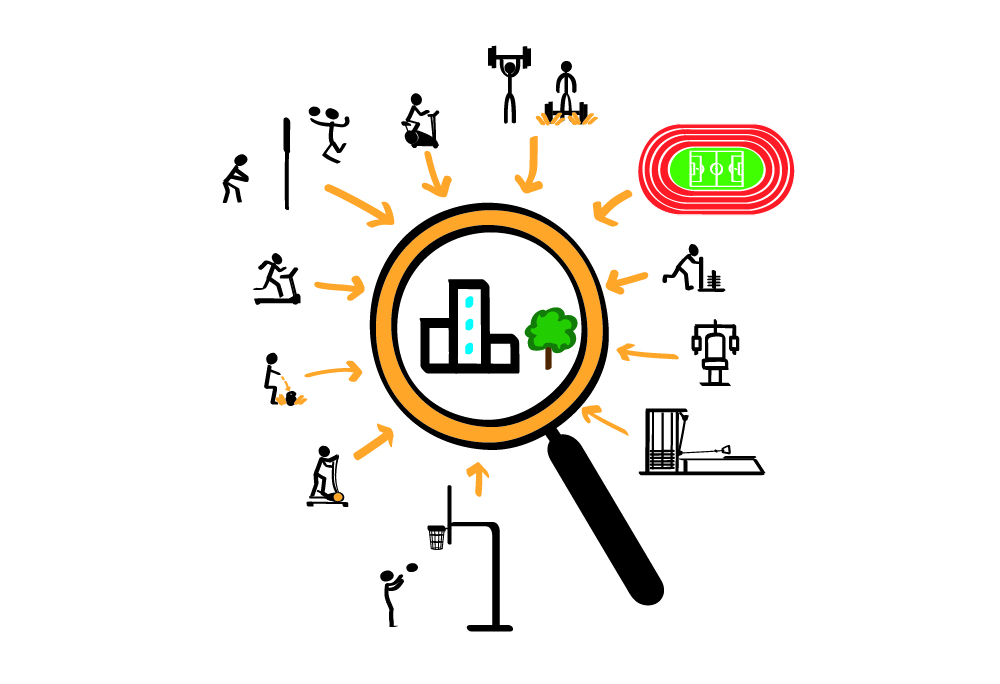
In sport, fitness and gym facilities, you find a lot of activities and equipment that create noise and vibrations.
If not controlled correctly, they can disburb neighbouring sites, neighbouring premises, and even the facility itself.
Atelier Crescendo have created this series of posts to make you understand:
- which activities are disturbing.
- how they are disturbing.
- who / what they can be disturing to.
- what the solutions are to reduce the noise and vibration disturbance.
This post suggests the first step of such a process: a complete and thorough Site Analysis.
Enjoy the read!
(See at the end the references used to confirm the concepts)

Do you want to be notified when new posts are published?
Why don’t you subscribe to Atelier Crescendo’s newsletter by clicking here?
Site analysis of sport, fitness and gym facilities
A complete and thorough site analysis of a facility serves the design of efficient and cost effective acoustic solutions.
Therefore, this first post lists a few questions to ask yourself for a site analysis and explains why they are important .
- What are the activities proposed?
- Who could the facility disturb? (i.e. what are the noise sensitive receptors?)
- Where are the noise sensitive receptors?
- When will the facility operate?
- What is the structure of the facility?
- What is the layout of the facility? (i.e. where will the different activities take place)
What are the activities proposed?
Various activities and equipment in sport, fitness and gym facilities produce noise and/or vibrations.
They do it in very different ways and at different intensities, leading to require very specific control solutions.
This section gives you a few examples of such activities and equipment.
Loud amplified sound

Most fitness and gym facilities play background music which is generally not a problem.
However, loud music (or sounds) may be played in some areas such as:
- activity and dance studios
- sports halls during events
- external sport areas during events
- others
Therefore, knowing which areas will produce loud amplified sound is important to take into account in the site analysis.
Vibrating machines
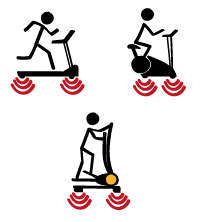
Some equipment that including rotating system (of some sort) not only produce noise but also vibrations. This includes:
- treadmills
- bikes
- ellipticals
- others
The above equipment produces (relatively) mild but ‘constant’ vibrations that are transmitted to the building structure.
Resistance machines
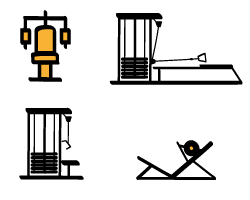
Most resistance machines involve lifting a stack of weights indirectly by performing a specific movement. They include:
- chest press
- leg press
- lat pulldown
- cable biceps/triceps bar
- seated row
- shoulder press
- others
Each time the stack drops, it creates an impact. This impact produces vibrations that are then transmitted to the building structure.
Functional training and sport areas

Sport, fitness and gym facilities sometimes include functional training and/or sport areas.
All these activities involve medium (up to 20-30 kg) or body weights dropped from heights that usually don’t exceed knee height (i.e. about 0.5 m).
They create repeated and (sometimes) synchronised impacts that produce vibrations of ‘medium intensity’. They include:
- running tracks
- slam ball/wall ball work
- sports pitches
- sports courts (tennis)
- sled training
- TRX training
- kettlebell training
- others
Free weight areas

Free weight areas are probably the most challenging areas to isolate in sport, fitness and gym facilities.
Most of the time, they involve:
- using medium (up to 20-30 kg) to very heavy (more than 50 kg) weights.
- lifting them from knee to above head height.
- Dropping them on the floor in, most of the time, an uncontrolled manner.
This process creates a very strong impact, with a lot of energy transmitted, that can be very difficult to mitigate.
Who could the facility disturb?
What is a noise sensitive receptor?
It is a property or a space located within the same building as the gym/sport facility or close to the site.
Examples of such receptors could be:
- Residential properties
- Commercial properties (i.e. offices, retail, etc)
- Education facilities
- Facilities with equipment sensitive to vibrations (such as laboratories, precision engineering facilities, etc).

One of the reasons why a site analysis is important is to help set relevant target for the acoustic treatment(s) should achieve.
This target, or also criterion, highly depends on the who/what the facility is likely to disturb.
Some noise sensitive receptors are more sensitive than others (see beside what a noise sensitive receptor is). For example:
- dwellings are generally more sensitive to gym noise than commercial properties (especially at night).
- Offices are more sensitive than retail premises.
- Some laboratories may have equipment sensitive to levels of vibrations that are not perceptible by the human body.
For residential receptors, you usually discuss and agree with the Local Authority. For other receptors, you could agree a criteria with the landlord or the neighbouring facilities.
Therefore, understanding who your sport, fitness and gym facility might disturb will help define the level of noise and/vibration mitigations.
Where are the noise sensitive receptors?
Knowing where the noise sensitive receptors are allows you to know if the cause of the disturbance is:
Just airborne noise
Note
What is airborne noise? it is noise that only propagates through the air or the atmosphere.
It is the case when the facilities and the receptors are structurally disconnected (i.e. not part of the same building).

Just 'structure-borne' noise
Note
What is ‘structure-borne’ noise? it is noise generated by vibrations that propagate through a structure (mostly building structures here) and are re-radiated into noise.
It is the case when the facilities and the receptors are structurally connected (i.e. they are part of the same building) but are fairly remote from one another (i.e. not adjacent)

Or both airborne noise and 'structure-borne' noise (and maybe pure vibration as well)
It is the case when the facility and the receptors are structurally connected and are close to one another (or even adjacent!).
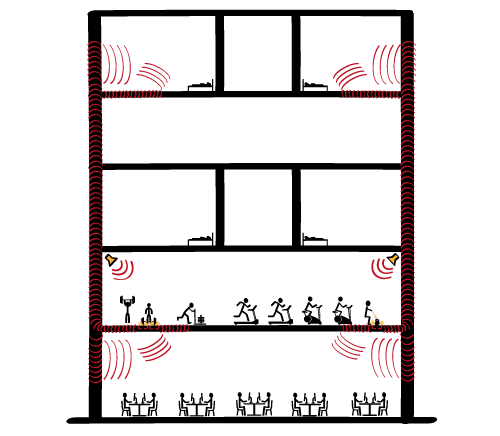
The relevant acoustic treatment to control the noise and/or vibrations from the facility varies for each situation above.
When will the facility operate?
Knowing when (i.e. which periods of the day) a sport, fitness and gym facility will operate
is very important to set relevant noise and/vibration control criteria.
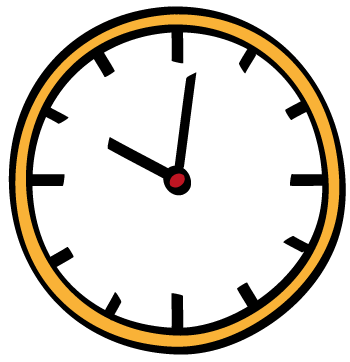
Choosing to operate a facility, with loud music and/or heavy impacts on the floor, during late evening and night time periods is likely to increase the cost of acoustic treatment needed.
Especially, when the facility is near or adjacent to dwellings.
Note
Late evening is approximately after 19:00 hours. Night time is approximately between 23:00 and 07:00 hours.
The reason of this is because you need to set very strigent noise/vibration criteria for the activities to not cause any disturbance to neighbours needing to rest or sleep.
External noise levels are also lower between 19:00 and 07:00 hours, so the activities or the music are more audible to neighbours.
Note
This section might be redundant as a lot of sport, fitness and gym facilities operate 24/7 and their peak hours are generally early in the morning (between 06:00 and 08:00 hours) and in the evening (between 17:00 and 20:00 hours)
What is the structure of the building where the facility is?
The structure of a building has a big influence in the acoustic treatment required.

The structure of the building influences:
- The sound insulation treatment for the floors and the walls.
- The vibration isolation treatment for the floors.
And you will generally need less material for heavy and stiff structures than for light structure.
Examples of heavy structures are in-situ concrete structures, brickwork, etc.
Examples of light structures are timber, mass timber, pre-cast concrete and metal frame structures.
Note
If you want to install a free weight area on a timber structure, it will be very challenging, or expensive, to control the ‘structure-borne‘ noise generated by the impacts of the weights on the floor.
(see above Section Where are the noise sensitive receptors? above for the definition of ‘structure-borne‘ noise)
What is the layout of the facility?
Second title - Heading 3
Planning the facilities layout is an integral part of noise and vibration control strategy.
It may be obvious, but:
- the further you locate the noisy and vibrating activities from the sensitive receptors,
- the less materials and acoustic treatment you need.
So by just optimising the layout of a facility, you can already control the noise and vibration impacts of the activities.
Below are three types of areas that are worth considering for such as process.
Note
The last two points are particularly useful to know if you need to select different sites and assess their suitability for sport, fitness and gym use.
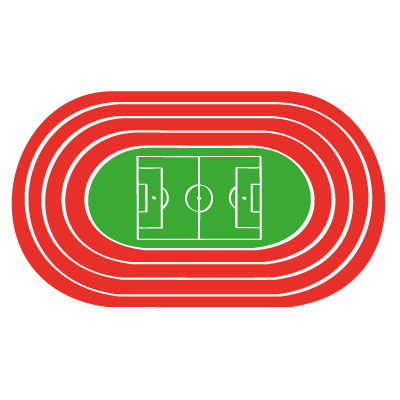
External running tracks, sport pitches and other areas
Some external sport areas produce noise that can be particularly disturbing when they are close to sensitive receptors.
Therefore, by locating these areas strategically, you can avoid some solutions like acoustic fences or earth bunds.
There are two main strategies here. Either you locate the areas:
- away from the receptors, or;
- ‘behind’ the some buildings (that of the facilities for example) that you use as acoustic screens.
Obviously, they are very much site dependant and sometimes can’t be implemented.
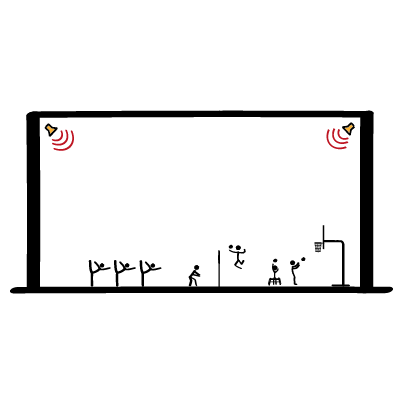
Studios, sports halls and other indoor areas
Most studios, sports hall and other indoor areas organise noisy activities or events with loud amplified sounds.
They can be particularly disturbing to receptors within the same building or in a neighbouring building.
Although you can control noise (and vibrations!) from these areas with the finishes and the construction of the building. It is also worth thinking about locating them as far away as possible from the receptors … when possible.
Another solution is to use secondary spaces (like bathrooms, stores, locker rooms, etc) as ‘buffer’ areas between the noisy spaces and the receptors.
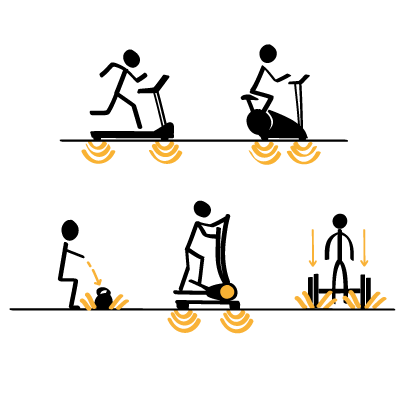
‘Vibrant’ equipment and activities
The vibrations generated by some equipment and activities (such as free weight activities, skate parks and even sports courts and studios) can be particuarly complicated and/or expensive to control.
Therefore, it will always be useful to think where they can go in the facilities to minimise the amounts of anti-vibration materials.
- at ground floor level and/or on heavy slabs.
- As far away as possible from the sensitive receptors.
